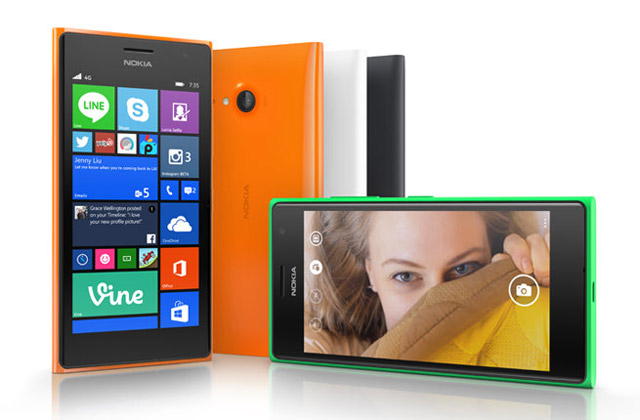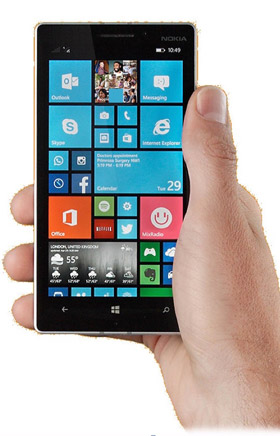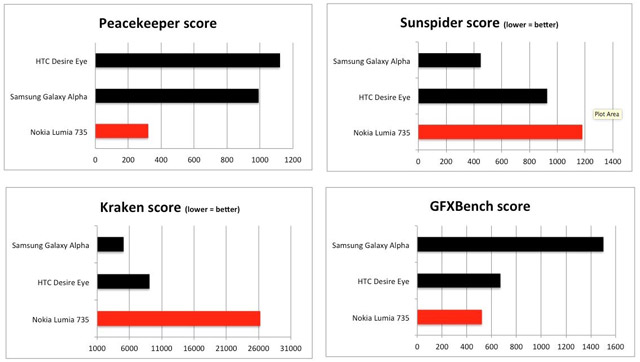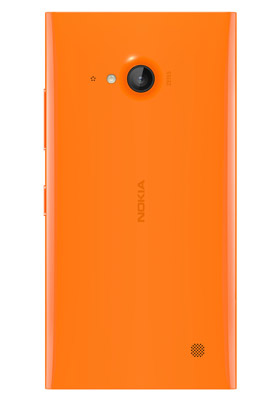
In order to neutralise my initial preconceptions about the low-priced Nokia Lumia 735, I gave it five full days to convince me of its qualities. In that time, I used it for typical home and office tasks like browsing, communicating, installing apps and taking pictures.
Then, to quantify its hardware performance, I used a set of specialised benchmarking tools. The screen’s properties were measured with the help of dedicated hardware, while the quality of the cameras was determined by simply shooting various pictures in different scenarios and settings.
Although the Lumia 735 isn’t coming to South Africa — or at least not through official distribution channels — it is very similar to the Lumia 730, introduced recently exclusively through Cell C.
The main differences between the two phones are that the 730 supports 3G but not LTE, whereas the 735 is a 4G device. Also, the 730 is a dual-Sim phone, which explains why it hasn’t been ranged by MTN and Vodacom, both of which have an aversion to such devices. In this review, I primarily compare the 735 with two other competitive, similarly sized smartphones.
Look and feel: one hand phone
The plastic, unibody-exterior of the Lumia 735 measures 134,7mm x 68,5mm x 8,9mm, making it fairly compact for a 4,7-inch device. It has a great feel in the hand and offers a firm but comfortable grip as a result of the slightly curved sides and back.
 Despite being made out of plastic, the phone feels solid and should easily survive rough handling or the occasional hard landing. It also doesn’t leave behind visible greasy finger smudges.
Despite being made out of plastic, the phone feels solid and should easily survive rough handling or the occasional hard landing. It also doesn’t leave behind visible greasy finger smudges.
The Lumia 735 unfortunately lacks a dedicated, physical button for taking pictures, which is a bit strange for a device that specifically targets photo and video enthusiasts. Because of its compact dimensions and good grip, the phone is ideal for use with just one hand.
Hardware: low-end specs
The internal hardware of the Lumia 735 is quite modest when compared to some Android powerhouses I’ve recently seen. The Windows Phone (8.1) operating system, on the other hand, isn’t as resource hungry as Android. The Lumia 735 features a low-end Qualcomm Snapdragon 400 chip that houses four separate Cortex-A7 cores, each working at a maximum of 1,2GHz.
To handle all graphics, there’s also an Adreno 305 GPU. While most modern smartphones pack 2GB (or even 3GB) of RAM for smooth multitasking, this Nokia Lumia has only 1GB. To cut the price even more, Nokia decided to put only 8GB of storage capacity in the Lumia 735. Since the operating system steals another 3GB, an unacceptable 5GB remains for apps and user content. It’s a good thing, then, that you can easily expand its capacity with an optional microSD card.
For wireless data transfer, the Lumia 735 supports most standards, including 3G, LTE (not the Lumia 730), Bluetooth, Wi-Fi and even NFC. Unfortunately, it can’t cope with 5GHz Wi-Fi signals, only the conventional 2,4GHz. Besides wireless transfer of data, the 735 also supports wireless transfer of energy. You do need to purchase an optional accessory to make use of this technology, though.
Benchmarks: poor performer
Naturally, I wanted to find out how the low-end hardware of the Lumia 735 would impact its performance. To do that, I ran three generic benchmark tests and one specific graphics test. I compared the results to those of the 5,2-inch HTC Desire Eye and the 4,7-inch Samsung Galaxy Alpha.

First up is Peacekeeper, a benchmark tool that takes the internal hardware, as well as the operating system and browser, into account when measuring performance. It shows that the Lumia 735 is no match for the two other devices. The Sunspider and Kraken tests measure the time in which a certain set of tasks is completed; therefore a lower value indicates better performance. Both tests confirmed what Peacekeeper had revealed before: the Nokia Lumia 735 is the worst performer of the bunch. In the graphics department, it doesn’t do much better according to GFXBench.
Battery life: all day long
To measure the performance of the Lumia 735’s 2 220mAh battery, I used two separate torture tests. The first one aims to drain the battery as fast as possible by continuously playing a full-HD video. The second one simulates typical home and office activities such as communicating, browsing and editing documents.
According to these tests, the Lumia 735 should have no problem lasting for an impressive nine hours of pure video watching. That’s enough to sit through the complete extended version of the Matrix trilogy.

Typical (continuous) home and office activities tend to strain the hardware a bit more, resulting in a lower battery life of five hours and 45 minutes. That’s even longer than the more costly Lumia 930 (5:15) but considerably shorter than the Lumia 1520 (6:50). Since the Lumia 735 has some smart energy-saving features on board that dim, and eventually turn off the screen when not used, it will have no problem reaching the end of a typical day.
Screen: acceptable
The Lumia 735 houses a 4,7-inch Amoled screen that can display 1 280×720 pixels, resulting in 316 pixels per inch. It is apparently equipped with scratch-resistant glass. Because my review-sample had to return in the same state I received it, I couldn’t seek the boundaries of this claim. The Gorilla Glass technology that facilitates this claim, however, has proven very effective over the last few years and has been applied on many smartphones other than this Lumia 735.
To determine the actual quality of the 735’s screen, I used a Spectracal C6 Colorimeter to measure brightness, contrast and the ability to display colours accurately. It showed me maximum brightness levels of 398cd/m2. Compared to the HTC Desire Eye (512cd/m2) and the Samsung Galaxy Alpha (521cd/m2), they are somewhat disappointing.
Nonetheless, when using the Lumia 735 in direct sunlight, you should have no trouble reading what’s on the screen. The contrast, on the other hand, is excellent and has a definite enhancing effect on the overall readability.
It’s just a shame the viewing angles are quite narrow. Screen quality quickly diminishes when you’re not looking straight at the screen, but from an angle. Finally, the accuracy of colour reproduction leaves a lot to be desired. Luckily, fiddling with the settings can partly compensate for that. In the end, the screen of the 735 is far from perfect, but considering its relatively low price tag price, this is acceptable.
 Cameras
Cameras
Microsoft aims to differentiate the Nokia Lumia 735 by focusing in on its 5-megapixel front camera, which should greatly enhance the quality of selfies and Skype calls. This front camera is equipped with a 1/4-inch sensor (f/2,4 aperture) and a wide-angle lens.
Ultimately, the Lumia 735’s selfie-cam produces high-quality images that look much better than that of any other Lumia devices I tested. It is no match for the vastly superior 13-megapixel HTC Desire Eye, though.
The 6,7-megapixel camera on the back has a 1,3/4-inch sensor (f/1,9 aperture) and an LED-flash. It also supports autofocus but lacks a wide-angle lens. Although the autofocus does a decent job, it can be very slow. General picture quality of the rear camera is quite good, but tends to be a bit dark in some situations.
The biggest drawback is the speed at which pictures can be taken. Not only does it take several seconds for the camera app to appear, there’s also an annoying delay when actually taking a photograph. I suspect this is the inevitable result of the underachieving Snapdragon 400 chip.
Both front and rear cameras can shoot decent video in full HD. The one in the front supports 30 frames per second while the back-cam can only capture 20fps. The 735 comes preinstalled with a couple of camera-related apps, like Lumia Camera and Lumia Selfie. Only the Lumia Camera app offers a multitude of configuration options while the selfie app is pretty straightforward.

Conclusion
Nokia’s Lumia 735 has some interesting features to offer, including a comfortable design, two good cameras and a relatively long battery life. Unfortunately, it’s not very fast and only comes with 8GB of storage. Although the storage capacity can be expanded, the lack of decent performance remains. Ultimately, the slow Snapdragon 400 chip becomes the Lumia 735’s Achilles heel.
If you don’t mind Android (and a slightly higher price), the HTC Desire Eye takes even better pictures and offers double the storage capacity. If you insist on having a Windows Phone device, then the Lumia 735 — or the 730 iteration available in South Africa through Cell C — is still one of the best selfie phones money can buy. Our rating? Seven out of 10. — © 2015 NewsCentral Media
- Although the Lumia 735 isn’t officially available in South Africa, the similar but dual-Sim Lumia 730 is available through Cell C for R4 500 prepaid or on contract

